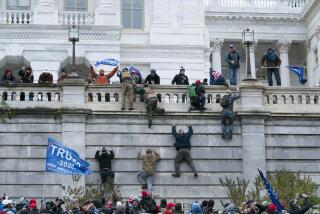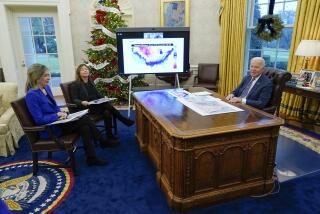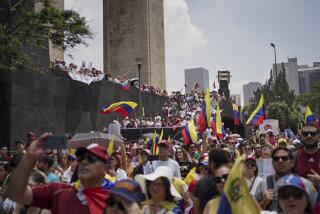‘Circles’ Round Up Support for Venezuelan President
CARACAS, Venezuela — Lina Ron hardly seems the heart of a revolution.
The chain-smoking widow lives in a tunnel beneath a busy Caracas street. Her ill-fitting clothes swallow her slight frame. Her only visible weapons are two cellular phones that ring incessantly.
Nevertheless, Ron represents the fundamental building block of President Hugo Chavez’s controversial attempt to transform Venezuelan society, alleviating the poverty that afflicts 80% of the population.
The 40-year-old former student organizer runs the country’s largest and most powerful Bolivarian Circle, one of thousands of grass-roots groups named after 19th century South American liberator Simon Bolivar.
Originally, the groups were supposed to foster community development and teach the fundamentals of Chavez’s so-called Bolivarian Revolution. But since the coup attempt in April that briefly forced Chavez from power, many circles--especially those in Caracas, the capital--have taken on the task of defending Chavez from those who continue to seek his ouster.
Some circle members boast openly of being armed, while others, like Ron, only hint darkly at the bloody consequences that could result from any effort to dislodge the embattled president.
At least some of the groups have spun out of control.
“If there are any problems, there will be blood on the streets,” said Jorge Barreto, a circle member who patrols near Chavez’s official residence and claims to have a 9-millimeter pistol close at hand.
The radicalization of the circles has led to fears of a far more deadly confrontation than the April 11 coup, when military officers and a coalition led by one of the country’s top business groups briefly seized power.
At least 17 people were killed during an exchange of gunfire between pro- and anti-government forces before Chavez was returned to office 48 hours later by loyal troops and massive street demonstrations.
Despite appearances, Ron is a firebrand who only recently was released from prison on charges that she incited a riot during a demonstration in February. Ron, who claims to coordinate “thousands” of other circle members, said the coup alerted the poor to the dangers facing the president.
“Chavez is loved and admired by the people. He will be defended to the death,” Ron said recently as she sat outside her home and headquarters, a subterranean passageway that leads to a parking garage beneath Venezuela’s Central Bank.
In response to the circles, neighborhood groups in wealthier sections have also begun arming themselves, according to some reports. Weapons sales have increased since the coup.
The growing hostility is another demonstration of the continuing polarization in Venezuelan society and the threat of a further explosion of violence.
“The circles are nothing more than a facade,” said Liliana Hernandez, a member of the opposition Justice First party. “They are armed groups supporting Chavez.”
Chavez’s revolution has never been well-defined. Part populism, part socialism, part direct democracy, it has deeply divided Venezuelan society, pitting unions, clergy, media and business against Chavez.
He has courted close relations with Cuba’s Fidel Castro and Iraq’s Saddam Hussein in an attempt to create a political bloc opposed to the United States and its globalization efforts. His fiery rhetoric and four-hour-long speeches have infuriated the opposition, though he has toned down his language since the coup.
Last year, he began encouraging the creation of the circles as a way to promote civic participation, to get small groups of citizens directly involved in the government. The idea was that citizens would apply for government funding to build sewers, to electrify rural communities and to form employment cooperatives.
But like nearly everything else in Chavez’s revolution, the circles themselves are ill-defined. There is a registration process, but not all the circles participate. There is a guidebook--62 pages long and filled with colorful graphics and vaguely spiritual exhortations to seek “the most pure of the human race”--but it has not been distributed to all the groups.
Even the national coordinator admits to not knowing how many circles exist or how many people they contain. Some estimates put the number of participants at more than 450,000.
“Anybody can get together and call themselves a Bolivarian Circle,” said Rodrigo Chaves, a surgeon who gave up his lucrative practice to coordinate the circles. “We are trying to put together a national registry now.”
It is clear that at least some of the circles are engaging in activities on the margin of the law.
Some call themselves warriors for Chavez, patrolling the grimy streets around the pale yellow presidential palace in downtown Caracas with radios to quickly mobilize the faithful.
These self-styled soldiers say they have contingency plans to flood the city center with Chavez supporters and quickly gain access to homemade weapons depots to confront any attempt to force Chavez from power.
Other groups have seized abandoned buildings, stripping them of doors, windows and building materials to give to the poor. They boast of clearing neighborhoods of drug dealers and gang members by beating them with whips and sticks.
It is also clear that other groups--perhaps the majority of the estimated 8,000 circles nationwide--are doing exactly what they are supposed to do, mobilizing poor communities to educate their residents, provide job training and improve their standard of living.
More than $500 million in government funds is available to the circles to help them achieve their projects, as long as they have a legal and accountable nonprofit structure in place.
Adriana Pena is a 36-year-old graphic designer who lives in the poor interior state of Guarico. She began to operate one of the circles only after the coup, when she realized that Chavez’s reforms were in danger of being usurped.
She gathered together other middle-class professionals and created a salon of sorts, going to poorer neighborhoods and teaching classes using books she had at home.
The only thing she teaches, she said, is that the poor have a right to participate in democracy. There is no instruction on how to be communists, or how to revolt against the rich.
“We had to help them understand the revolution,” she said. “They are poor, with a low academic level.”
The best and worst of the groups can be seen in the blocks surrounding downtown Caracas, a collection of crumbling high-rises and cracked streets as grimly urban as anything in the movie “Blade Runner.”
In one abandoned building, Yasmin Manuitt teaches ceramics classes for children and has built concrete facades for local businesses that make them look, incongruously, like the dwarfs’ cottage in “Snow White.”
The 39-year-old navy veteran patrols the streets in a camouflage jacket and cap and black high heels, and carries a radio that keeps her in contact with other “guardians” of Chavez’s revolution.
She claims no special political loyalty to Chavez, though she supports the goal of his reforms.
“We don’t want to help any one person,” she said. “We want to help everyone.”
Nearby, Barreto, one of Manuitt’s friends, strolled along an abandoned street where gang members once congregated.
Barreto, also a veteran, patrols the area around the National Pantheon, where Venezuela’s heroes are buried. He said he doesn’t seek violence but is ready for it.
He said Chavez has finally given him, and the rest of the poor, a measure of power.
“We have been humiliated for years. It’s hard to buy a home. It’s difficult to raise our children,” he said. “We are prepared and we are ready.... If they kill one of ours, we’ll take out one of theirs.”
There are no signs that the circles are organized paramilitary groups, training for armed combat.
Instead, those who boast of being armed seem more like militia members, ready to sally forth with their own pistols and rifles to support Chavez.
But that, say opposition members, is what makes them even more dangerous. With little order or discipline imposed from above, the circles are a wild card in any confrontation between those for and against Chavez.
“We call them circles of terror, or circles of criminals. They ... impose the idea in the poor that they must take up arms,” said Hidalgo Valero, an ex-colonel in the National Guard arrested recently after leading a parade against Chavez of former military officers.
Even Chavez government officials acknowledge that some of the circles are unruly. National coordinator Chaves, for example, called Ron’s circle a disappointment because of its focus on defending the president.
Chaves said most of the circles concentrate not on politics, but on improving their communities. They build community centers, promote local commerce and educate one another in a country that has long skimped on services for the poor.
After 40 years of corrupt political rule, Chaves said, the circles represent the best chance to reform Venezuelan society from the ground up.
“Venezuela is a garden that was destroyed,” Chaves said. “You can’t expect all of our tomatoes to be beautiful and shiny right away.”
More to Read
Sign up for Essential California
The most important California stories and recommendations in your inbox every morning.
You may occasionally receive promotional content from the Los Angeles Times.










